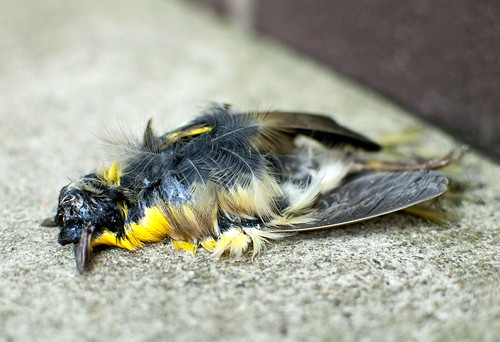
More than 800 birds have died on Main Campus this year.
After a few months of raising awareness, a well-known problem often overlooked by students, staff and faculty is making a breakthrough in January in Tyler School of Art.
For approximately four years, Temple’s grounds department has been keeping track of the number of dead birds found on Main Campus.
This year, between 800 and 1,000 migratory birds have lost their lives at Temple because of collisions with glass. This is a direct result of the low cost, sustainable and aesthetically pleasing tall glass buildings that have become common in architecture.
“It’s not a Temple problem,” grounds department superintendent Glenn Eck said. “It’s a modern construction-methods problem.”
Philadelphia is directly in the center of traditional migratory flyways, so birds that die because of these fatal impacts are not accustomed to the city-life structure, and don’t notice the windows.
A list of 31 bird species, including the yellow rail, northern waterthrush and the indigo bunting, have been found dead on Main Campus due to window collisions.
“Coming into the city to take this job, I was surprised by the types of birds that I was seeing lying dead on the ground,” Eck said.
Science and outreach coordinator of the Audubon society Keith Russell said that Temple’s new glass covered buildings, trees and vegetation draws in migratory birds.
“I’ve never seen anywhere in Philadelphia with a worse problem,” Russell said.
Buildings on Main Campus that are most prone to bird collisions include the Student Center, the TECH Center, Paley Library and Ritter Hall.
The reflective characteristics of glass makes it invisible to birds, who see trees or plants reflected in the window, but not the glass itself.
This problem has prompted faculty members, students, the Philadelphia Zoo and Audubon to get involved at Temple, aiming to promote a change.
The old, traditional solution to making glass visible to birds was to place hawk cutouts on some glass buildings around Main Campus. These two-dimensional predatory bird images are still being used in hopes of scaring away birds that would otherwise keep flying, until impact.
“[The hawk cutouts are] a little inconclusive,” Eck said. “Let’s put it this way: It wasn’t the magic bullet.”
Ornilux bird protection glass, originated from Germany, has patterned, UV reflective coating. This expensive glass is visible to birds and virtually unnoticeable to humans.
“If there were to be solutions, they would have to be solutions that we could afford at Temple,” Sandra McDade, director of the office of sustainability, said.
Because Ornilux is so costly, surface-care film has been created with small horizontal lines about one inch apart, that deters birds from going any farther because they know they couldn’t fit through.
This surface-care film was tested at the Philadelphia Zoo on the Big Cat Falls exhibit, which used to be extremely collision-prone.
“They’ve had literally, effectively 100 percent turnaround since they put the film up,” Eck said.
Senior biology major Haley Gilles got involved in a research project during Spring 2011 through the Creative Arts, Research and Scholarship Program, where she is testing this patterned film on windows in Beury Hall.
“It’s definitely helping,” Gilles said. “The window film is a solution to the problem.”
After being contacted by interested faculty members, area head for graphic and interactive design Alice Drueding coordinated the first “Bird’s Eye View” project for more than 100 sophomore, junior and senior design students.
The idea behind the project was to produce a creative pattern that could be printed on a 13-inch by 19-inch piece of film as an alternative to simple horizontal lines.
“The design is dictated by it’s content,” Drueding said. “These are decorative, but at the same time we wanted to incorporate elements in it that made a viewer who did not really know what it was about, think about birds.”
The idea of embellishing the window glass could be a selling point for institutions considering using the bird-safe film.
“If you can take windows and you can start to put interesting patterns that are more complex and beautiful, it may stimulate the mind and help people perform better in the long run,” Russell said.
“Bird’s Eye View” was entirely implemented into design courses this semester, where students spent more than a month researching and another month designing in class. They will receive a grade on their final product.
Selected designs will be exhibited in Tyler School of Art from Jan. 17 until Feb. 27, just prior to the spring migration period. Drueding, happy with the design student’s work, hopes the exhibit will promote observations and raise awareness.
Sophomore graphic design major Lisa Spiller said she thinks it was a good project to be implemented into the design curriculum this semester.
“It was an interesting design puzzle with quite a few teaching tools, and it also helps to resolve a serious environmental issue,” Spiller said.
Students’ work in the design exhibit will be judged and prizes will be awarded. Some of the designs may also be submitted to surface-care film companies, in hopes of influencing a new, decorative idea that could be tested and implemented on buildings throughout the nation.
Lauren Hertzler can be reached at lauren.hertzler@temple.edu.


Be the first to comment